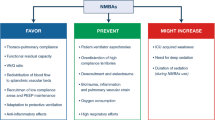Abstract
Muscle relaxants are clinically used to facilitate endotracheal intubation and artificial ventilation, to relax hypertone muscles, to decrease oxygen consumption and to make surgical operations possible. For these indications depolarizing and non-depolarizing muscle relaxants are routinely used in both the operation suite and the intensive care unit. Besides for the facilitation of endotracheal intubation is nowadays such a routine administration of relaxants during intensive care treatment controversial. The occurrence of immobilization atrophy and the subsequent muscle weakness resulting in problems with weaning of the patients from the ventilator and with mobilization, have led to a more selective use of the compounds. Complete paralysis with insufficient sedation may in many patients have contributed to the post-intensive care psychological problems. Therefore a more rational use depending on the needs of the patients and the characteristics of the available agents are requested. The various muscle relaxants do have different pharmacological properties that make it possible to select the drug to be administered in relation to the need and the pathological condition of the patient. For example some muscle relaxants cause a considerable increase in heart rate and should therefore be avoided in patients with tachycardia [1]. Other relaxants cause histamine release [2, 3] leading to hypotension, tachycardia and bronchoconstriction.
Access this chapter
Tax calculation will be finalised at checkout
Purchases are for personal use only
Preview
Unable to display preview. Download preview PDF.
Similar content being viewed by others
References
Booij LHDJ, Edwards RP, Sohn YL, Miller RD (1980) Cardiovascular and neuromuscular effects of Org NV45, pancuronium, metocurine and d-tubocurarine in dogs. Anesth Analg 59: 26–30
Booij LHDJ, Krieg N, Crul JF (1980) Intradermal histamine releasing effect caused by Org NC45. A comparison with pancuronium, metocurine and d-tubocurarine. Acta Anaesthesiol Scand 24: 393–394
Robertson EN, Booij LHDJ, Fragen RI, Crul JF (1983) Clinical comparison of atracurium and vecuronium (Org-NC45). Br J Anaesth 55: 125–130
Gronert GA, They RA (1975) Pathophysiology of hyperkalemia induced by succinylcholine. Anesthesiology 43: 89–99
Koller ME, Breivik H, Greider P, Jones DJ, Smith RB (1984) Synergistic effect of acidosis and succinyl-induced hyperkalemia in spinal cord transected rats. Acta Anaesthesiol Scand 28: 87–90
Bowman WC (1980) Pharmacology of neuromuscular function. J Wright & Sons Ltd, Bristol, pp 99–107
Edwards RP, Miller RD, Roizen MF, Ham J, Way WL, Lake CR, Roderick L (1979) Cardiac responses to imipramine and pancuronium during anesthesia with halothane or enflurane. Anesthesiology 50: 421–425
Waud BE, Waud DR (1980) Interaction of calcium and potassium with neuromuscular blocking agents. Br J Anaesth 52: 863–866
Funk DI, Crul JF, vd Pol FM (1980) Effects of change in acid-base balance on neuromuscular blockade produced by Org NC 45. Acta Anaesthesiol Scand 24: 119–124
Argov Z, Mastaglia FL (1979) Disorders of neuromuscular transmission caused by drugs. N Engl J Med 301: 409–413
Booij LHDJ, Miller RD, Crul JF (1978) Neostigmine and 4-aminopyridine antagonism of lincomycin-pancuronium blockade in man. Anesth Analg 57: 316–321
Rutten JMJ, Booij LHDJ, Rutten CLJ, Crul JF (1980) The comparative neuromuscular blocking effects of some aminoglycoside anitbiotics. Acta Anaesth Be1g 31: 293–306
Glisson SN, El-Etr AA, Lim R (1979) Prolongation of pancuronium-induced neuromuscular blockade by intravenous infusion of nitroglycerin. Anesthesiology 51: 47–49
Glisson SN, Sandrez MM, El-Etr AA, Lim RA (1980) Nitroglycerin and the neuromuscular blockade produced by gallamine, succinylcholine, d-tubocurarine and pancuronium. Anesth Analg 59: 117–122
Bruckner J, Thomas Jr KC, Bikhazi GB, Foldes FF (1980) Neuromuscular drug interaction of clinical importance. Anesth Analg 69: 678–682
Bikhazi GB, Leung I, Foldes FF (1982) Interaction of neuromuscular blocking agents with calcium channel blockers. Anesthesiology 57: A268
Durant NN, Nguyen N, Katz RL (1984) Potentiation of neuromuscular blockade by verapamil. Anesthesiology 60: 298–303
Healy TEJ, O’Shea M, Massey J (1981) Disopyramide and neuromuscular transmission. Br J Anaesth 53: 495–498
Harrak MD, Way WL, Katzmay BG (1970) The interaction of d-tubocurarine with antiarrhythmic drugs. Anesthesiology 33: 406–410
Doll DC, Rosenberg H (1979) Antagonism of neuromuscular blockade by theophylline. Anesth Analg 58: 139–140
Westra P, Keulemans GTP, Houwertjes MC, Hardonk MJ, Meyer DKF (1981) Meachanisms underlying the prolonged duration of action of muscle relaxants caused by extrahepatic cholestasis. Br J Anaesth 53: 217–227
Agoston S, Vermeer GA, Kersten UW, Scaf AHJ (1978) A preliminary investigation of the renal and hepatic excretion of gallamine triethiodide in man. Br J Anaesth 50: 345–351
Camu F, D’Hollander A (1978) Neuromuscular blockade of fazadinium bromide (AH 8165) in renal failure patients. Acta Anaesthesiol Scand 22: 221–226
Booij LHDJ, Vree TB, van de Pol F, Crul JF (1982) Pharmacodynamics of vecuronium and pancuronium in cats with and without ligated renal pedicles. Acta Anaesth Belg 33: 157–165
Hunter JM, Jones RD, Utting JE (1984) Comparison of vecuronium, atracurium and tubocurarine in normal patients and in patients with no renal function. Br J Anaesth 56: 941–951
Editor information
Editors and Affiliations
Rights and permissions
Copyright information
© 1986 Springer-Verlag Berlin Heidelberg
About this paper
Cite this paper
Booij, L.H. (1986). Rational Use of Muscle Relaxants During Intensive Care Treatment. In: Vincent, J.L. (eds) 6th International Symposium on Intensive Care and Emergency Medicine. Update in Intensive Care and Emergency Medicine, vol 1. Springer, Berlin, Heidelberg. https://doi.org/10.1007/978-3-642-82801-0_82
Download citation
DOI: https://doi.org/10.1007/978-3-642-82801-0_82
Publisher Name: Springer, Berlin, Heidelberg
Print ISBN: 978-3-540-16508-8
Online ISBN: 978-3-642-82801-0
eBook Packages: Springer Book Archive




